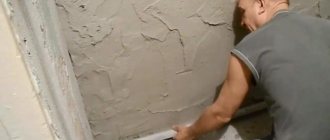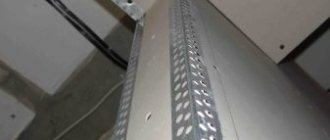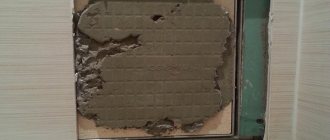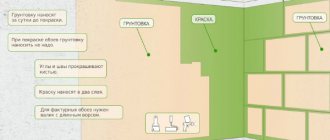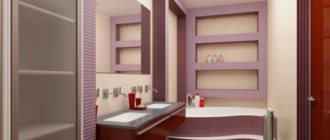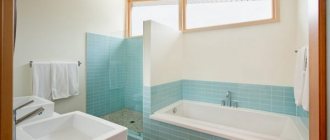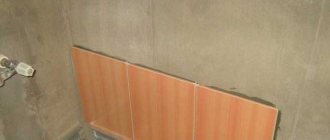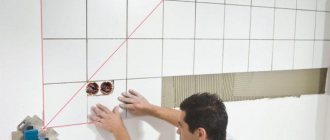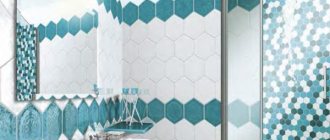8190 0 0
Savig June 14, 2017Specialization: master of interior finishing works. I am well versed in power tools for repair and construction. Formerly a teacher at a radio engineering college.
Before installing the tiles, plasterboard sheets must be carefully prepared
Don't know how to prepare drywall for tiling? The experience I have accumulated allows me to say that any home craftsman can cope with this task. Detailed instructions containing relevant photo illustrations will help me prove this.
Gypsum and tiles are a good combination
Tile requires perfectly smooth walls. However, in many homes this is very difficult to achieve. Many defects in the form of unevenness, as well as the general curvature of the walls, become a big problem when we need to glue tiles on them.
Drywall is one of the fastest ways to level walls. We can mount products made from this material on a frame or directly on the walls in the shortest possible time and without the need to have high knowledge of finishing. At the same time, using a double layer of gypsum plasterboard in combination with moisture-resistant options, it is possible to create a durable base that can withstand the weight of the tiles, will not collapse under severe external influences, and can even be used in rooms with high humidity levels, such as a bathroom.
Important! All of the above is possible if the tiles are laid well. And the primer plays a critical role in this matter.
Ways to protect drywall from moisture in the bathroom ↑
It is necessary to indicate that only moisture-resistant sheets marked GKLV are used in the bathroom. The protective cardboard layer of this material is green or blue. Impregnation with an antiseptic hydrophobic composition helps it resist high humidity. Additional protective measures are carried out as follows.
- Before installation, the back surface of the gypsum board is treated with waterproofing mastic from Knauf or Flachendicht. It does not contain organic solvents; after application and complete drying, a hydro-vapor barrier film with a high degree of adhesion is formed on the surface.
- After installation, treat the ends with exposed gypsum fiber with silicone sealant or Dolphin water-repellent.
- A good result is obtained by treating the sheets with PVA glue after applying a deep penetration primer.
- Treatment with “Hydrostop” produced by Knauf or rubber waterproofing.
- The internal corners formed by the joints of the sheets are treated with primer, after which a waterproofing tape 200 mm wide is glued. The waterproofing agent is reapplied on top so that the tape is completely covered. It is necessary to apply the product evenly so that there are no problems when laying the tiles. External corners are also protected in the same way.
- Pay special attention to the lower part of the walls, near the floor. The appearance of moisture in this area is most likely. For processing, pasting or coating materials based on bitumen are used. They begin to spread the mastic on the floor, then on the wall so that it extends onto the walls (to a height of about 200 mm). The walls near the shower cabin and bathtub are completely processed. For better protection, the mastic is applied in several layers.
- Adhesive waterproofing is used: glassine, roofing felt or roofing felt is glued onto the back side of the drywall, after treating it with a bitumen or polymer composition. Bitumen-polymer membranes are also effective.
- Waterproofing penetrating materials consisting of cement, crushed sand, and chemically active substances are applied to gypsum board sheets in a layer of 1–3 mm. Crystals of the substance, penetrating into pores and cracks, seal them. In this case, the base should also be treated (so that it does not absorb condensation). Products such as “Silar”, “Dolphin”, “Hydrosite” and others are used.
- Protecting gypsum fiber boards with ordinary oil paint is effective. It should be applied to the back side of the material with a brush in two or three layers. The front side is not processed in this way: this will make it impossible to cover the walls with ceramic tiles.
- Walls can be decorated with paint. For application to gypsum boards, select a waterproof paint, which is applied after treating the base with a primer.
All these methods will be effective only if there is good forced ventilation in the room. If this is not possible, the use of drywall should be abandoned.
Is it necessary to putty drywall under tiles?
The question of whether it is necessary to plaster the gypsum board before gluing the tiles is asked by many, and the answer to it is obvious - no. After all, the main task of putty is to level the surface, whereas in the case of drywall everything is already as level as possible. All that needs to be done is to prepare the plasterboard surface for better adhesion with tile adhesive, for which a primer is used.
Moisture-resistant drywall
Finishing the walls in the bathroom with plasterboard
Moisture-resistant plasterboard is always used as a material for the bathroom, which is endowed with special physical characteristics that allow it to be used in a humid environment. This material is easy to use to create various structural elements. Bathroom partitions made of plasterboard can be easily and quickly constructed without the use of special tools or practical skills. Almost everyone can purchase the required amount of material, build the frame themselves and sew it up with sheets. Plasterboard partitions in the bathroom can have different geometric shapes and functionality. They can hide errors in the design of the room, act as a box for pipes or be niches for storing bath accessories and household chemicals.
Are you wondering how to cover a bathtub with plasterboard? Work procedure and installation recommendations
What do they want to achieve by using drywall primer for tiles?
- Ensuring better adhesion of the tiles to the surface of the drywall;
- The glue is distributed more evenly over the primed surface;
- When dismantling the tiles, the process will not occur together with fragments of plasterboard sheets;
- The primer helps prevent the appearance of mold and mildew on the walls;
- The soil also has water-repellent properties, which prevents gypsum board from swelling even when used in places with high humidity.
Choosing a primer for the job
Ideal options for priming drywall are latex or acrylic based compositions. These types of primers have all the necessary properties and also dry quite quickly. Already four hours after application, you can begin directly gluing the tiles. However, the ideal time to start further work, be it putty or gluing porcelain tiles, is better to start after a day. It is important to remember that when applied to a plasterboard sheet, the primer should not contain a solvent.
In this case, it is necessary to choose the type of product that corresponds to the further finishing. For example, if it is acrylic paint, then it is better to choose an acrylic primer. But in general, all types of soil for such materials are divided into penetrating and strengthening. The first differs in that it has a finer filler. This composition allows it to penetrate to a significant depth - up to 10 millimeters. If you have to prime a surface that has already been finished in some way, then the second option is chosen. By the way, penetrating compounds are also more expensive.
In general, you need to look at the following parameters:
- In the penetrating primer, the solids content does not exceed 12 percent, which ensures its deeper penetration into the body of the gypsum board;
- It is easy to distinguish the compositions by appearance. In the strengthening primer, due to the higher content of solid components, the color is almost milky. At the same time, in most cases, the penetrating version of the liquid appears translucent and cloudy;
- If gypsum plasterboard is applied to the surface, the penetrating composition will be absorbed very quickly, while the strengthening composition will leave a clearly visible glossy mark on the surface.
Types of coating waterproofing
Materials for coating waterproofing are sold in the form of dry or granular powders, semi-dry pastes, or in ready-to-use liquid form. Also, coating mixtures can be one-component or two-component, the latter, as a rule, are quick-drying and more elastic.
- Bitumen-polymer mastics are sold in finished form. They are made from bitumen binder and polymer fillers. This is an excellent insulating material that has high elongation and recovery rates, is non-toxic, odorless, resistant to temperature changes and aggressive environments. You can use bitumen-polymer mastic under tiles only on the bathroom floor, subject to subsequent filling with a thin screed.
Advice! Coating waterproofing is most relevant in small bathrooms, up to 7 square meters. m.
- After complete polymerization, the composition is leveled and becomes a seamless surface with excellent moisture-proof properties and high elasticity. It is recommended to apply a thin screed over bitumen-latex waterproofing. And after it dries, you can lay the tiles.
- Budget moisture protection. One of the most inexpensive and short-lived ways to provide waterproofing in the bathroom is acrylic enamel. It is applied to the surface in several thick layers (at least 3-4 layers). Soon the paint will crack. As an alternative, some use liquid glass, but it can provide the necessary water barrier only in combination with a plasticizer, which makes the layer plastic after drying.
The procedure for priming plasterboard sheets under tiles
- Only a clean surface needs to be primed. Therefore, we thoroughly clean the outer layer of the gypsum board from dust and dirt;
- Having prepared the solution and poured it into a container for ease of work, we begin to apply the composition to the surface of the plasterboard using a roller with fine pile or a fairly wide brush. In this case, corners and other fragments that require a more subtle approach can be treated with a narrow brush;
- Do not forget to do vertical shading in order to cover the entire surface of the sheet with an even layer without smudges or missing spots;
- After the first layer of primer has set, it is highly advisable to repeat the procedure.
Do I need to prime drywall before plastering it?
Tile is not laid on a gypsum board base as often as plastering is done. This method is the most popular in matters of further finishing of drywall. But is it necessary to treat this material with a primer before plastering? In general, yes, since the main task of this method, which is to increase adhesion, is also relevant here.
Since putty, unlike tile itself, cannot provide a smooth surface simply by the mere fact of its presence, it is necessary to prepare this very surface for it. And the main thing here is to process the seams and the locations of the screws. The process looks like this:
- After installing the gypsum board sheets, we apply a primer to the seams and the locations of the screws, after which we treat them with plaster;
- As soon as the putty has dried, we again treat the gypsum board with a primer, but this time the entire surface. As soon as it dries, apply a leveling layer of putty of small thickness. If necessary, a reinforcing mesh is installed;
- After this, we coat the already applied putty with a primer. And then all that remains is to apply the finishing layer.
Thus, using soil and, possibly, a reinforcing mesh, we have created a layer of plaster that will last as long as possible and withstand the most severe external influences.
Materials and tools
How to prepare drywall for tiles will be described further, but before that you should collect a set of necessary tools and materials. For puttying and priming you will need:
- spatulas, narrow and wide
- notched trowel for tiles
- building level
- tile cutter
- rubber hammer
- spacer plastic crosses, corners
- roller or brush to apply primer to drywall under tiles
- reinforced tape
- sandpaper
- container for primer, putty
One of the frequently asked questions to professionals is “What is the thickness of drywall for walls under tiles?” The most optimal sheet thickness is 12.5 mm.
